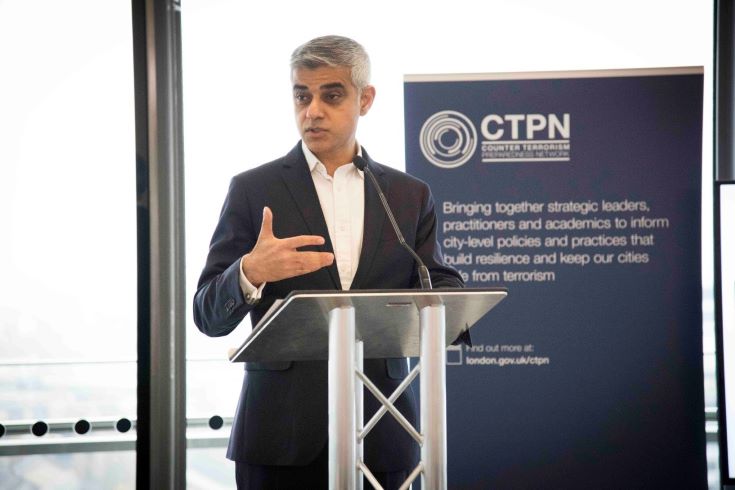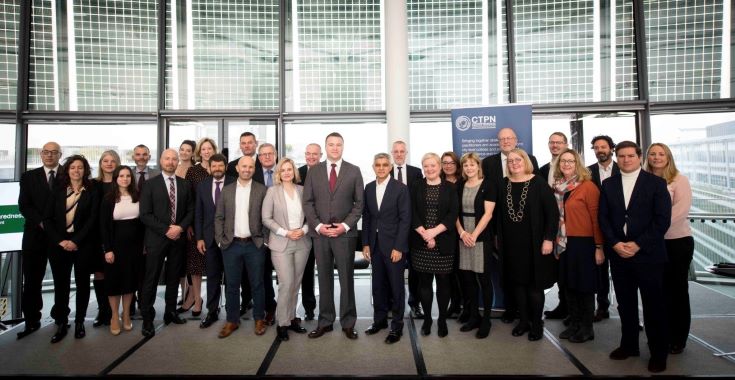Launch of the Counter Terrorism Preparedness Network
In November 2019, London’s City Hall hosted the launch of the Counter Terrorism Preparedness Network (CTPN) in response to the threat of terrorism in the world’s major cities. Claire Sanders attended the event – here’s her report.

London's Mayor, Sadiq Khan opened the event. All photos: CTPN and London Resilience Group
The idea for a network of cities was developed in June, 2018 to help achieve multi-agency action at a city level. Representatives from six cities – Barcelona, Greater Manchester, London, Paris, Rotterdam and Stockholm with academic partners – came together to discuss the challenges and needs for action under the leadership of the London Resilience Group. Five reports have been released and the initiative culminated in the network’s launch on November 15.
The network aims to promote dialogue and to share experiences and good practice to develop new approaches and embed strategic preparedness in a truly international cohort of cities.
London’s Mayor, Sadiq Khan, opened the event by outlining the need for such an approach. He referenced the UK’s threat level having been downgraded from severe to substantial as a positive move, but also reinforced the chilling reality that: “Evil assumes many guises and the scourge of extremism can have devastating consequences.”
Protecting the safety and security of citizens so that they can go about their daily lives unhindered and without fear is of paramount importance to the network and at the core of its ethos.
By strengthening and insulating communities, the Mayor said, we can take the fight to those who seek to radicalise vulnerable individuals, and building resilience at the community level is the underlying key to the CTPN’s success. The Mayor concluded his speech by urging communities and cities to: “Build bridges, not put up walls,” in order to uphold values of decency and democracy.
According to Lord Toby Harris, who led an independent review into London’s ability to respond to major terrorist incidents, there is a clear need for swift action because by 2035, it is predicted that 60 per cent of the world’s population will be living in cities. His review found that, following substantial investment in counter-terrorism measures, response times to incidents have improved markedly over the last six years.
Lord Harris suggested that increasing police presence could help, but this might not mitigate all risks and he asked: “What level of risk is acceptable?” This is a key issue when it comes to how peoples’ daily lives are affected. Should we be changing the look and feel of cities to make us feel safer?
Inevitably, a city trying to improve structural resilience may encounter pitfalls such as slow-moving decision-making protocols, planning barriers and budget challenges. In terms of businesses, there is a question around responsibility towards employee and customer safety. For instance, during the London Bridge attack of 2017, some bars and restaurants opened their doors to fleeing members of the public, others closed theirs.
A panel discussion on the ways to build resilience included thoughts on educating children, staff training in the workplace and how to update this on a regular basis, and the need for clear information following an incident. Responses at the city level must be co-ordinated and organised, both in terms of getting back to normal and in the dissemination of advice. As the panel suggested, it is easy to shut areas of the city down, but harder to get them open and going again. Clear, comprehensive strategies are needed and trust between agencies, businesses and the public is a fundamental pillar at all levels. Collaboration between leaders and a directional framework to help a move to whole systems approaches will enable connections between all scales and all services.
The panel emphasised the need for everyone to be aware of their own role in an incident and what part technology plays; crowd modelling, drone monitoring and social media analytics will all become important aspects of protection. With this comes generational opportunities – changes in outlook and society will – and should – influence planning and preparedness.

Members of the CTPN at the event
The CTPN hopes to improve the resilience of cities that have already suffered terrorist attacks and is keen to help other cities that as yet might not have been directly affected. It is a voluntary and self-funded international collaboration, drawing its members from academia and city authorities.
Its priorities for 2020/2021 include the enhancement of city-to-city learning through conferences and workshops; supporting and monitoring report recommendations; exploring additional research opportunities, most notably two reports on strategic communications and cyber terrorism.
The overview and full reports from the CTPN can be viewed here and its work will be showcased in the next edition of Crisis Response Journal, due out this March.
Thumbnail: rastudio|123rf
Claire Sanders, 04/02/2020